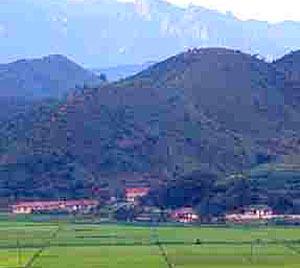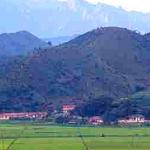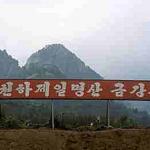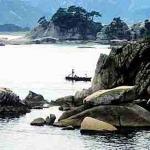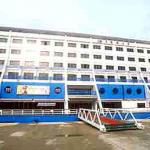12,001 Miracles At North Korea's Mount Kumgang
Can the sound of a temple bell call forth a mountain range? It would seem unlikely. But in the case of Korea's "holy of holies" Mount Kumgang (aka Kumgangsan, Geumgangsan National Park or the "Diamond Mountains"), nothing appears to be impossible.
Poets, artists and mystics have long celebrated Kumgangsan as a place of miraculous happenings. The Buddhist scripture the Avatamska Sutra records that "12,000 miracles" are created by the 12,000 peaks of this spectacular range, which is also said to be the home of the Buddha. Rugged stone sentinels, so jagged that they could have been cut out with a fretsaw, tower over the raging waterfalls and ever-changing flora of the valleys making up the 2,400 square kilometre National Park.
A visit to Kumgangsan is obviously a "peak" experience. The problem is that getting there is not so easy, as the range lies wholly within North Korea. But while politicians have been arguing about North Korea's nuclear program on the world stage, behind the scenes a real dialogue between North and South Korea has been taking place. Within the Korean National Tourism Organisation there is a Department of Inter-Korea Tourism, and on October 3, 2003, delegates from South and North Korea will jointly celebrate National Foundation Day in the North Korean capital Pyongyang.
On September 1 this year (2003), I was privileged to be along for the ride with the very first group of Westerners and South Korean tourists allowed to enter North Korea by road, via an east coast route through the Demilitarised Zone (DMZ). This land route into North Korea opened briefly in February 2003, solely to allow family reunions between long-separated North and South Koreans, but six weeks later, the border was inexplicably closed once again. The re-opening of the border came as a milestone, the first time that tourists, travellers and others have been permitted to cross the DMZ.
In the absence of a land route, the Hyundai Company has since 1998 been running cruises from the South Korean port of Gaesong to Kumgangsan. These tours attracted large numbers of South Koreans, but were costly and inconvenient to run. Things came to a head in August 2003 when Chung Mon-Hun, the heir to the Hyundai throne, committed suicide over rumours of financial scandals surrounding Kumgangsan and other company operations.
But despite this sad occurrence, the show still goes on. We set out towards the DMZ from Gaesong, in a convoy of about twelve busses, past military camps and through hills dotted with rifle ranges. The setting feels really weird - I feel as though I'm already in North Korea, and my eyeballs haven't even left their sockets yet.
Along the way, the beaches are all fenced off with barbed wire, access being allowed only during daylight hours - and even then only through narrow gates about one kilometre apart. Soon we reach the "outer" DMZ, the North Limit Line, beyond which civilians may not enter without papers. From here, the South Korean border post lies 13 km away.
Border formalities are simple enough, but include the temporary confiscation of mobile phones and laptop computers. The North Koreans will not allow these contraptions into their half of Korea, for fear of "contaminating" the locals with foreign ideas. The "Hermit Kingdom" seems in fact to be a hermetically sealed fiefdom; one suspects that if it could be arranged, the North Koreans would even prevent the locals from breathing the same air as the visitors.
The "inner" DMZ is 4 km wide, with the Military Demarcation Line (MDL) between the North and South lying halfway. The DMZ is super-intensively patrolled, with both sides having a reputation for trigger-happiness. A few more minutes of tension, and our history-making convoy enters North Korea!
The contrast between the demeanour of the troops on the two sides of the border could not be greater. Some of the North Korean guards open up a little, then suddenly remember the party line and quickly return to their previous unflinching mien. Others stare slack-jawed, in total incomprehension.
Still others refuse to make eye-contact at all, maybe on orders from their superiors. But as I am to discover later, this is not invariably the case. When under scrutiny, the troops are tough and unyielding, but in a natural environment such as in the National Park, the North Korean guides are amongst the warmest people you could ever wish to meet.
North of the DMZ, the road along which we are travelling is cordoned off with a fence topped with three thick strands of barbed wire. Red-coated people sit with their backs to us. Others go about their daily chores, walking or (rarely) cycling along the dusty rural roads. Once again, no eye-contact is made - the people have evidently been very well briefed indeed.
The terrain in these foothills of Mount Kumgang, geographically the youngest area on the planet, is a tortuously twisted rockscape of wind-and-water-smoothed boulders scrunched into fantastic shapes - some like smiling heads, others more serious-looking - but none so stony-faced as some of the North Korean troops we have encountered.
After the shock of my first encounter with North Korean officials, I'm expecting their CIQ (Customs, Immigration and Quarantine) procedures to be something akin to a new form of torture. But surprisingly, checking through is smooth and relatively painless. I am even allowed to keep my zoom camera lens, an unexpected concession in a land where lenses over 160 mm focal-length are officially banned.
Visitors to Kumgangsan are housed in the floating Hotel Haegeumgang, which somehow found its way here from Australia's Great Barrier Reef, via Vietnam. You can't get a Foster's lager at this towering monstrosity nowadays, but the accommodation is still of acceptable if somewhat faded standard. It doesn't take long to discover, however, that there are no ATMs in the North, and only Korean credit cards are valid; US dollars or South Korean Won in cash are the only means of payment accepted.
The next day, an intermittent rain is insufficient to dampen our group's enthusiasm, as we set out for the "Holy of Holies". Kumgangsan is divided into two sections - Oegumgang or the Outer Diamond Mountains, and Naegumgang, the Inner Diamond Mountains. Naegumgang was formerly the major pilgrimage area of Kumgangsan, with an outstanding temple, cliff hermitage and rock carving of the Buddha being the only man-made things to have survived the Korean War.
Sadly, the Inner Diamond Mountains section is nowadays off-limits to visitors. But the hiking trails of the Outer Diamond Mountains are ample consolation. Our ascent of the Manmulsang peaks, as befits these awesome mountains, is a challenging climb along a track so steep that in places, staircases are needed. In other places, high stone steps mark out the path. All around, the pinnacles soar like stone needles from the valley floor - this would most definitely not be the best parachuting zone.
Also making the ascent is a 75 year-old lady from Seoul. "I have a bit of a heart condition", she says, "but I made a vow to climb Mount Kumgang before I die." Her attitude, following in the long tradition of Buddhist pilgrimage, comes as a real inspiration.
When the Confucian rulers of Korea during the Joseon Dynasty (from 1392 right through to 1910) tried to suppress Buddhism in the country, they made an exception for Kumgangsan, and continued to make contributions to the temples on the sacred mountain. For Chinese envoys to Korea in the 15th and 16th Centuries, Mt Kumgang was at the very top of their wish list of places to visit. Later, during the Japanese occupation of the early 20th Century, a number of painters tried to make realistic sketches of Kumgangsan, only to be stymied by the ever-changing nature of the panorama.
One of the North Korean guides, Jun Chon-Song, speaks a little English and offers a friendly welcome. He shows a keen interest in photography - understandably so, as this area is so scenic that you could just about take pictures even without a camera. From Jeolbuam Rock, about ten minutes walk below the top of saddle, I stop to take some photos of the high Manmulsang Rocks - a fortuitous decision indeed, as ten minutes later a dense bank of fog rolls in across the mountaintops.
The walk down the mountain is possibly more difficult than the ascent, but there is a great treat in store. At the Onjeonggak Rest Area (a complex of restaurants and shops alongside the Kumgangsan Culture Hall), I get to watch a performance by the Pyongyang Moranbong Circus, one of the world's finest acrobatic troupes. Seemingly-impossible balancing and trapeze acts are followed by wild seesaw jumps and plate-throwing acts - and to keep the crowd laughing, a pair of total endearing clowns.
By now, near-terminal muscle ache has set in, so a trip to the Kumgangsan hot springs spa is most welcome. At the baths, men and women bathe in separate sections, thus minimising the opportunity to show off different birthday suits (the only things worn). Like a kid let loose in a gymnasium I'm a little scared of doing the wrong thing, but fortunately Mr Park Chyun-Kyu, Director of Inter-Korea Tourism, shows me the right way to wade through the jade-pebble foot-bath, and how to shower under the rock cascades. Best of all, the 40-degree germanium bath soon has my legs feeling as though they could tackle a 100 km hike.
The next day, we enter REAL unfenced North Korean territory, where life goes on under the watchful gaze of giant posters of the "Dear Leader", Kim-Jong-Il. Sadly, though, no sooner does Hyundai open up new areas than the North Koreans start to build new barbed-wire fences along the roadsides. Our destination is the beautiful and extensive Lake Sam-il-po, where atypically the man-made structures - bridges, lake pagodas and rest pavilions - actually augment the total scenic experience.
Near the lake, the seashore at Haekumgang Beach is a mini-version of Vietnam's Halong Bay. Fractured rocky pinnacles roar like dragons out of the turquoise sea. These so-called "sea diamonds" are a perfect backdrop for what could one day be a popular beach resort.
Sadly, it is time to leave Kumgangsan. This trip has been both a revelation and a tantalising glimpse of a national park worthy of prolonged exploration. At the border, a giant statue of the Buddha looks back towards Kumgangsan, and it is hard not to feel that the mountain is in very good hands indeed.
One thing is for certain - a wedge has been driven though the walls of the hermetically-sealed nation, North Korea. Slowly, rays of light are passing in both directions along the sides of the wedge. If tourist visits can assist in a gradual opening up of the world's last Stalinist country, the effects could be profound indeed.
A few days later, I am highly privileged to be staying for a short time at Naksansa Temple, home to Avalokitesvara, the Buddhist Bodhisattva of Perfect Compassion, in South Korea's Gangwondo Province. This sublime and otherworldly retreat welcomes guests for short stays, offering a powerful and intensive insight into the monastic way of life.
As the head priest sounds the towering bronze bell of the temple, a booming sound as though from the depths of the primordial universe seems to reverberate through space and time, calling the whole universe into being. I am weirdly carried back to Kumgangsan, with a striking image of the mountain peaks arising within my "inner vision". The experience is as vivid as it is totally unexpected.
I later learn that this bell is known as the Brahma Bell, representing beings in the underworld. According to tradition, this bell has the power to give relief to all beings in heaven and hell. If the sound of the Brahma Bell can melt a diamond-hard mountain, what more could it do for the long-suffering people of North Korea?
If Kumgangsan is the land of 12,000 miracles, could the anticipated reunification of Korea be miracle number 12,001?
* * * * *
Fact File
Getting There: Asiana Airlines provides excellent service on its daily flights to Seoul in South Korea. From Seoul, tours to North Korea are organised by Classical Oriental Tours, the only licensed North Korea operator in the Southern Hemisphere. Contact details:
Classic Oriental Tours
Travel House
Level 3 / 35 Grafton Street
Woollahra NSW 2025
Australia
Ph: (+61 2) 9657 2020
Fax: (+61 2) 9657 2029
Email: travel@classicoriental.com.au
Things to Remember:
There are no ATMs in the North, and only South Korean credit cards are accepted; take plenty of cash in US dollars or South Korean Won.
Photographing North Korean troops, guides and many of the structures is prohibited. If in doubt, ask!
Guide-books:
Lonely Planet's Korea guide (5th edition, 2001) has a very useful section on North Korea.
* * * * *
 ThingsAsian
ThingsAsian